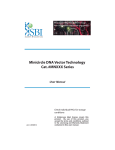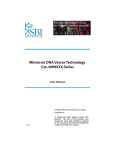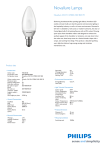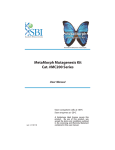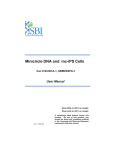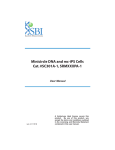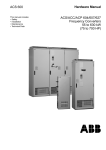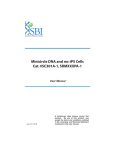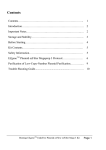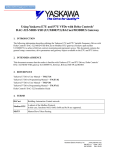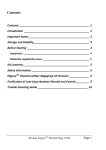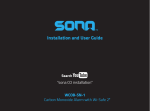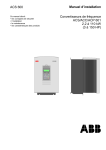Download MC-Easy Minicircle DNA Production Kit User Protocol
Transcript
TM MC-Easy Minicircle DNA Production Kit User Protocol The MC-Easy system enables a simple, reproducible and efficient way to produce high quality Minicircle DNA for your experiments. The finely tuned growth and induction media produce minicircle DNA that is free of parental and genomic DNA contamination. The Kit also includes an additional, innovative method for degrading any contaminating genomic DNA using an ATP-dependent DNase reagent that will selectively remove genomic DNA but without affecting the quality of the minicircle DNA. The MC-Easy kit will produce clean and effective minicircle DNA every time. The system comes complete with a special minicircle DNA transfection reagent, MC-Fection, that works well with most cell lines. Choose from the minicircle production kit that includes the engineered E. coli producer strain ZYCY10P3S2T (cat# MN920A-1) or select the minicircle production and isolation kit alone (MN910A-1). Product Contents MC-EasyTM Minicircle production kit (for 5 preps) Contents 5X Minicircle Growth medium 10X Induction Medium Quantity 200 ml 100 ml Minicircle DNA Re-purification kit (for 5) Endotoxin free water Minicirle-safe DNase ATP (25mM) 10X DNase buffer Precipitation Buffer 2 ml DNA Centrifugal Filter for DNA purification and Concentration columns 5 ml 125 µl 125 µl 250 µl 0.5 ml MC-Fection (transfection reagent for minicicle DNA) 100 µl Minicircle producer strain ZYCY10P3S2T E. coli (included in cat# MN920A‐1) 1 5 vials of competent cells 5 Protocols A. Transformation of ZYCY10P3S2T E. coli Minicircle producer strain A-1. Transforming ZYCY10P3S2T E. coli cells; 1) Thaw competent cells on ice. 2) Add DNA from ligation reaction, using 1-5 µl of the reaction to one vial of ZYCY10P3S2T cells moving the pipette through the cells while dispensing. Gently tap tubes to mix. 3) Alternatively, for parental plasmid transformation add 20-100 ng DNA to the vial. 4) Incubate cells on ice for 30 minutes. 5) Heat-shock cells for 30 seconds in a 42°C water bath. Do not shake. 6) Place cells on ice for 2 minutes. A-2. Recovery This procedure is very important for Kanamycin resistant constructs. 1) Add 0.2 ml of room temperature S.O.C. Medium to the vial. Transfer to a bacterial culture tube. 2) For tubes containing ligation reactions, shake at 250 rpm (30°C or 37°C) for 90 minutes. 3) For tubes containing parental plasmid DNA: shake at 250 rpm (30°C or 37°C) for 60 minutes. A-3. Plating and Mini-Preps 1) Pre-warm culture plates to 37°C. Chilled plates will decrease ZYCY10P3S2T E coli transformation efficiency. 2) Spread 50-200 µl of bacterial solution on an LB plate containing 50 µg/ml kanamycin. Incubate overnight at 37°C. 3) Keep the remaining solution at room temperature, and spread onto a new plate the next day in case no colonies are seen. 2 4) Pick 3-5 colonies to grow in 2 ml of LB containing 50 μg/ ml kanamycin. Grow overnight and then extract the plasmid by miniprep. 5) Check the minicircle parental plasmid by restriction digest analysis and sequencing. 6) If the parental plasmid looks correct, make glycerol stocks from the miniprep bacterial culture and store them at -80°C. You are now ready to produce minicircle DNA from the parental plasmid DNA. B. Growth and Induction of the Minicircle Producer Strain The following steps describe production of minicircle DNA from the parental minicircle plasmid which was produced in the previous steps. Day 1: Inoculation 1) On day 1 at about 5:00 PM, inoculate 2 ml of LB containing 50 μg/m kanamycin with a single colony or an inoculation loop of glycerol stock bacteria. Incubate at 30°C shaking at 250 rpm for 1-2 hours. Note: The bacteria must be fresh. LB agar + kanamycin plates stored at 4°C are only fresh for 1 week. Glycerol stocks are good for up to one year. 2) After 1-2 hrs measure the OD600 to calculate the inoculate volume. Use the following formula to calculate inoculate volume: For example, if the OD600 reading is 0.01, the inoculate amount is: 3) Dilute 5X Growth medium to 1X: 160 ml of sterile deionized water 3 +40 ml of 5X Growth Medium 200 ml Total volume 1X Growth Medium 4) Inoculate 200 ml of 1X Growth Medium with inoculate volume calculated in step 2. 5) Grow bacteria overnight at 30°C, shaking at 250 rpm in a 1 liter sterile flask*. The overnight culture should not go beyond 16 hrs. *If using a different sized flask for the overnight culture, keep the ratio of flask size to O/N culture volume at 5:1 (vol:vol). Day 2: Induction 1) On Day 2 after about 16 hrs of overnight growth, measure the pH and OD600 of the culture medium. The pH should be around 7 and the OD600 should be between 4-6. Record the OD600 and the pH in your laboratory notebook in case you need to troubleshoot later. a. If the OD600 > 8 and the pH < 6.5, you must restart the protocol from the beginning. Check the temperature and ventilation of the incubator. b. If the OD600 is between 6 and 8, it is okay to proceed to step 3. 2) If the OD600 is between 4-6, combine 200 ml of the overnight culture with 200 ml of 1X Induction medium. a. Add 20 ml of 10X Induction medium and 180 ml of sterile deionized water (room temperature). b. The pH should now be between 6.9 and 7.4. If the pH is <6.9, add NaOH to adjust the pH to 7. 4 3) If the OD600 is between 6-8, combine 200 ml of the overnight culture with 400 ml of 1X Induction medium. a. Add 40 ml of 10X Induction medium and 360 ml of sterile deionized water (room temperature). b. Divide the culture (600 ml total) into two 1-liter sterile culture flasks (300 ml each). c. The pH should now be between 6.9 and 7.4. If the pH is <6.9, add NaOH to adjust the pH to 7. 4) Incubate the mixture again at 30°C, shaking at 250 rpm for 5- 5.5 hours. Longer induction times may increase bacterial death and cause genomic DNA contamination. 5) Take 1ml of the bacterial culture and do a miniprep followed by restriction digest analysis to check the quality of minicircle plasmid. 6) Pellet bacterial at 4°C and store the pellet at -20°C overnight. Day 3: Extraction of Minicircle plasmid 1) Follow protocol of Invitrogen’s PureLink HiPure Plasmid Purification Kit but use 2-3 Maxi columns for each minicircle construct produced. 2) Alternatively, use the QIAGEN MegaPrep Kit protocol with one column, but use double the volume of P1, P2 and P3 Buffers. 3) Digest 0.5 μg minicircle plasmid with a restriction enzyme and run an agarose gel to check the quality again. 4) If the quality is good, go to the transfection procedure offered in Section I to check the function. 5) If the minicircle preparation contains genomic DNA or parental DNA or both, continue with the next steps (Sections F-H) of this protocol. a. If the parental DNA contamination is more than 10% higher than the minicircle DNA yield, you must start again. Please refer to the troubleshooting section for more details. 5 b. It is okay to proceed with excess genomic DNA contamination (in the absence of parental DNA contamination). This is an example of a purified minicircle plasmid that does not have any genomic or parental plasmid contamination. If your preparation looks like this, you can proceed by transfecting the minicircles into your cells-of-interest. DNA Ladder L1 L2 L3 L4 L1, Parental DNA of SRM100PA‐ 1 cut by Mfe1 L2, L3,L4, Minicircle DNA of SRM100PA‐1 cut by Mfe1 6 This is an example of a minicircle plasmid that has both genomic DNA and parental plasmid contamination. If your minicircle preparation looks like this, you will need to perform the Removal of Genomic and Parental Plasmid DNA contamination steps (Section C.) before transfecting it into your cells-of-interest. DNA Ladder L1 L2 Genomic DNA Parental DNA Minicircle L1, Minicircle DNA contaminated with genomic DNA and parental DNA. L2, Minicircle DNA treated with Nde1 and Minicircle‐safe DNAse. 7 C. Removal of Genomic and Parental Plasmid DNA contamination Parental DNA and genomic DNA contamination are common problems in minicircle DNA production. Follow this protocol to remove parental plasmid and genomic DNA contamination. 1) Linearize parental DNA with 1 or 2 restriction enzymes that cut the bacterial backbone without cutting inside the minicircle DNA. You should use a plasmid editor software to help you choose the appropriate restriction enzymes. 2) Then use Minicircle-safe DNase to digest the linearized DNA, according to the protocol below. (Minicircle-safe DNase is included in the kit.) ~400 μl plasmid (use the whole amount you obtained in the last step) 20 μl 25 mM ATP 50 μl 10X Reaction Buffer 20 μl DNase ~10 μl water 500 µl Total Reaction Volume Incubate at 37°C for 2-16 hours 3) Inactivate DNase by incubation at 70°C for 30 minutes. 4) Check Result: Take 1-2 µl from DNase-treated and untreated samples. Digest them with same restriction enzyme and run agarose gel to check the result. If the reaction was successful, you should see minicircle DNA present, but no parental plasmid or genomic DNA contamination in the sample. 8 Removal of in-activated DNase and Restriction Enzymes 1) Add 50 µl of Precipitation Buffer (1:10 the volume of the reaction in the previous step) to the DNase-treated solution and mix by pipetting. 2) Add 1.1 ml of 100% ethanol and mix by inverting. 3) Put on ice for 30 min. 4) Centrifuge at 15000x g for 15 minutes. Carefully discard supernatant. Do not disturb DNA pellet. 5) Dissolve plasmid with 1-2 ml of TE buffer. 6) Optional: Continue to next step using 2ml DNA Centrifugal column to remove dNTPs and salts. 7) Alternatively, if a the ATP and dNTPs do not influence your downstream experiment, you can wash pellet with 1 ml of 70% ethanol. Centrifuge at 15000x g for 5 minutes. Discard supernatant. When pellet is dry, resuspend in endotoxin-free water (supplied) or endotoxin-free TE buffer. Optional: Removal of ATP and dNTPs with 2ml DNA Centrifugal columns 2ml DNA Centrifugal columns can be used to remove dNTPs, primers, other macromolecular components, salts and buffers. 1) Insert the 2ml DNA Centrifugal filter into a filtrate collection tube. 2) Add up to 2 ml of sample to the device and cover with concentrate collection tube. 3) Place filter device into the centrifuge rotor and counterbalance with a similar device. a. For a swinging bucket rotor, spin at 1,000x g for 30 min or 3000x g for 10 min. b. For a fixed angle rotor, spin at 7,500 × g for 10-30 min. 9 4) Wash step: add 2 ml of the buffer you want and repeat spin procedure. 5) Remove the assembled device from the centrifuge and separate the 2ml DNA Centrifugal column from the filtrate collection tube. 6) To recover the concentrated solute, invert the filter column to concentrate collection tube. Spin for 2 minutes at 300-1,000 × g to transfer the concentrated sample from the column to the tube. NOTE: For optimal recovery, perform the reverse spin immediately. 7) Measure plasmid concentration and check A260/A280 ratio. The A260/A280 ratio should be 1.8-1.9. Transfect Minicircle DNA with MC-FectionTM to validate the construct 1) Seed 1.5X105 target cells/ ml per well in a 12-well plate. SBI uses 293T cells, but you can use any target cells that you prefer. 2) Incubate overnight at 37°C. Cells should be 50%-70% confluent the next day. 3) In a sterile Eppendorf tube add the following (per well): 100 µl DMEM (without FBS) 1 µg Minicircle DNA 2.5 µl MC-FectionTM 4) Mix by vortexing vigorously for a few seconds. Incubate at room temperature for 15 min. 5) Add the mixture to one well of a 12-well plate and incubate at 37°C, 5% CO2 overnight. 6) Check for fluorescent reporter protein expression (e.g. GFP or RFP), or other marker gene, or protein-of-interest expression. 10










